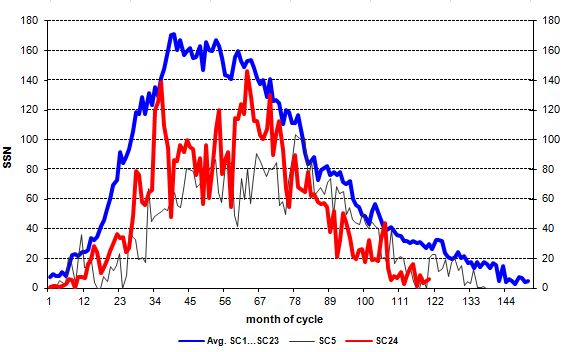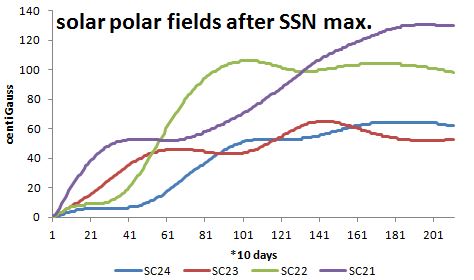The sun in November 2018
By Frank Bosse and Prof. Fritz Vahrenholt
(Translated by P Gosselin)
Our sun was also very much less active in November than normal, comparing all solar cycles 1-23 up to month no. 120 since since the beginning of the systematic survey in 1755, the first year of solar cycle 1.The latest observed SSN (sunspot number) was a meager 5.9 for the monthly average.
On 16 days the sun was completely “spotless”. The maximum number over the days of November was 15, which does not mean that there were 15 spots – no, the number indicates that 5 spots were observed in a maximum of 1 spot group. So there was very low spot activity, only 20% of the average value.
Fig. 1: The current solar cycle 24 (red) compared to a mean cycle calculated as the average of cycles 1-23 (blue) and cycle 5 (black), which for years was quite similar and observed around 1800.
Fig.1 clearly shows that we had probably already arrived at the solar minimum at the beginning of 2018 (month 110 in the diagram). Will there be another “flare up” like in SC 5? The probability is rather low.
A comparison of all the observed solar cycles so far, 120 months into the cycle:

Fig. 2: The summed up monthly deviations between the observed SSN numbers and the respective mean value (blue in Fig.1) for all cycles up to the current cycle month 120 of SC 24.
The measurements of Cycle 24 are well recorded. It is very likely that we will stay in the minimum for another year with very little activity. This can also be seen in the solar polar fields, which stagnate at their maximum value. To illustrate this, we have graphically processed them as mean values from the solar northern and southern hemispheres. We always looked at the same time period, between the zero point (it is the respective spot maximum) and 2110 days afterwards, that is the last measuring point of the SC24 on November 27, 2018:

Fig. 3: The temporal development of the polar solar fields of the sun since 1980. The strength in the spot minimum, at the end of the respective graph when the fields become stationary and hardly change, is a good indicator for the activity of the subsequent cycle.
Figure 3 shows very clearly how hesitantly the increase in the current cycle occurred. The three predecessor cycles showed a much faster development after the zero crossing. Later, SC 24 then settled on a slightly higher value than SC 23. This could mean that SC 25 could become slightly stronger from 2020. But one should not expect too much accuracy from the method. It is clear that SC 25 will by far not become as strong as SC23 and 22, i.e. sub-normally active, see Fig. 2.
We’ll keep you up to date!





The solar disk has been spotless for 10 straight days. Here is what SILSO says:
“INFO FROM SIDC – RWC BELGIUM 2018 Dec 26 12:30UTC
Solar activity was at very low levels. The Sun was spotless. No coronal
mass ejections (CMEs) were observed over the last 24 hours. The greater
than 10 MeV proton flux was at nominal values. A narrow extension of the
positive polarity northern polar coronal hole (CH) has nearly finished its
transit of the central meridian.
Solar activity is expected to remain at very low levels.
Solar wind speed varied between 340 and 370 km/s (DSCOVR). Bz ranged from
-5 to +4 nT. The interplanetary magnetic field remained primarily directed
towards the Sun (negative sector). Quiet geomagnetic conditions were
observed.
Quiet geomagnetic conditions are expected to continue. The wind stream
associated with the extension of the northern polar CH is expected to
arrive on 28 or 29 December. This may result in active geomagnetic
conditions, a minor storming interval is not excluded.”
http://sidc.oma.be/
BTW, for those that may not know. The sunspot count is the longest running record of observations of any kind in science. Because of the ever increasing ability to make detailed observations as technology advances the sunspot count has to be adjusted in order the maintain some kind of continuity. The SIDC does this adjustment mathematically. Another approach to maintaining the continuity of the sunspot count is that which the Layman’s sunspot count uses. http://landscheidt.info/?q=node%2F50 which basically using an instrument as identical as possible to that used in earlier counts.
[…] Current Solar Cycle The 3rd Quietest In More Than 250 Years Of Observation (Source) […]
I wonder what the “area” under the sunspot number per cycle would look like. Would this value represent surface, expressed solar energy?
Doug: The fig.2 is nothing else then “area” under the SSN / cycle, mothly resolved and normed to an “average cycle” shown in blue in fig.1. And yes: The TSI some kind of your mentioned “solar energy” coincidences remarkably to the SSN, see https://data.giss.nasa.gov/modelforce/solar.irradiance/tsi_CMIP5.png
[…] Read more at No Tricks Zone […]
[…] source : https://notrickszone.com/ […]
[…] https://notrickszone.com/2018/12/26/current-solar-cycle-the-3rd-quietest-in-more-than-250-years-of-ob… […]
[…] https://notrickszone.com/2018/12/26/current-solar-cycle-the-3rd-quietest-in-more-than-250-years-of-ob… […]